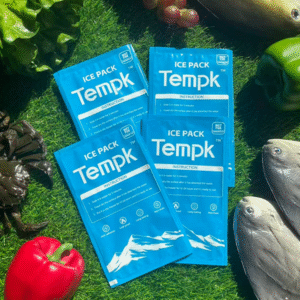How Do Dry Ice Packs Ensure Safe and Efficient Meat Shipping in 2025?
When it comes to shipping meat, maintaining the correct temperature is essential to preserve both safety and quality. Dry ice packs are the preferred solution for many businesses in the cold chain industry, ensuring meat products arrive at their destination frozen and fresh. This article dives into the science behind dry ice, its advantages over traditional methods, and how businesses can optimize their shipping practices using this essential cooling tool.
-
How do dry ice packs keep meat frozen during shipping?
-
What are the best practices and legal rules for shipping meat with dry ice in 2025?
-
How much dry ice should you use for meat shipping?
-
What innovations and trends are shaping dry ice solutions in the cold chain?
How Do Dry Ice Packs Keep Meat Frozen During Shipping?
Dry ice is carbon dioxide in its solid form, sublimating directly into gas without passing through a liquid state. This unique property makes dry ice incredibly efficient for maintaining sub-zero temperatures, which is essential for shipping meat products like beef, poultry, and seafood. Dry ice packs provide a cooling effect that can last anywhere from 24 to 72 hours, depending on conditions.
How Does Dry Ice Maintain the Right Temperature for Meat Shipping?
-
Extended Cooling Time: Dry ice keeps meat frozen for extended periods without the need for refrigeration. The cold effect it produces is ideal for long-distance shipping.
-
No Liquid Residue: Unlike regular ice, which melts into water, dry ice sublimates, ensuring no liquid residue that could cause contamination or sogginess in the meat packaging.
-
Stable and Consistent Temperature: The ability of dry ice to maintain a consistent low temperature prevents temperature fluctuations that could lead to spoilage and bacterial growth, ensuring that meat products stay fresh.
| Cooling Method | Temperature Range | Duration | Ideal Use Case |
|---|---|---|---|
| Dry Ice Packs | -78.5°C (-109.3°F) | 24–72 hours | Long-distance meat shipping |
| Gel Packs | 0°C (32°F) | 12–24 hours | Short-distance shipments |
| Ice Packs | 0°C (32°F) | 6–24 hours | Less temperature-sensitive items |
Why Should You Choose Dry Ice for Meat Shipping?
1. Maintaining Freshness for Extended Shipments
For meat to remain fresh during long shipments, it’s crucial to avoid any temperature fluctuations. Dry ice helps to ensure that the product stays frozen, especially on international or cross-country shipments. Without it, meat products would spoil, putting both health and quality at risk. Dry ice offers the consistent cold needed for the meat to stay fresh.
2. Preventing Bacterial Growth and Spoilage
Meat is highly susceptible to bacteria growth, and these microorganisms thrive in warmer temperatures. Dry ice maintains temperatures well below freezing, effectively minimizing bacterial activity and ensuring the meat stays safe for consumption.
3. Cost-Effective for Long-Distance Shipping
Though dry ice can be more expensive than traditional ice or gel packs, its ability to maintain a consistent, low temperature over extended periods makes it cost-effective for long-distance shipping. Fewer spoilage-related losses and reduced disruptions in temperature translate into fewer returns and higher customer satisfaction.
How Much Dry Ice Should You Use for Meat Shipping?
The amount of dry ice required depends on several factors, including the weight of the meat, the duration of the transit, and the insulation quality of the packaging.
General Guidelines:
-
1–2 lb of dry ice per 5 lb of meat for short to medium trips.
-
5–10 lb of dry ice per 10–15 lb of frozen food for each 24-hour period.
-
Always include a 20-30% buffer to account for delays and temperature fluctuations, particularly in warmer months.
Dry Ice Calculation Example:
For a 10 lb shipment of frozen meat with a 2-day transit time, you would need approximately 12 lb of dry ice:
-
Dry Ice = 10 lb × 1.1 × 2 × 1.25 = 12.4 lb
This ensures the meat stays frozen during the entire transit period. Be sure to test shipments under similar conditions before scaling up.
What Innovations and Trends Are Shaping Dry Ice Solutions for Meat Shipping in 2025?
The cold chain logistics industry is evolving rapidly. In 2025, several trends are shaping the way dry ice is used for meat shipping:
1. AI-Driven Temperature Management
Sophisticated algorithms and IoT sensors are now integrated into cold chain logistics. These devices allow real-time temperature tracking, helping businesses adjust dry ice quantities based on real-time conditions. This minimizes spoilage and ensures the meat stays within the required temperature range throughout transit.
2. Sustainable Dry Ice Production
As demand for eco-friendly practices rises, innovations in dry ice production are focusing on sustainability. Carbon capture techniques are being used to produce “carbon-neutral” dry ice, while reusable and recyclable insulation materials are gaining traction.
3. Smart Packaging Sensors
New smart packaging solutions are integrating temperature and location sensors, allowing businesses to monitor the condition of their shipments. If the temperature rises above a set threshold, the system can trigger the release of additional coolant or reroute the shipment to prevent spoilage.
Best Practices for Shipping Meat with Dry Ice in 2025
-
Layering and Insulation: Use a “sandwich” method, placing dry ice blocks on the bottom and top of the meat, with a barrier between the ice and the product to avoid direct contact. Ensure the package is well-insulated to reduce dry ice consumption.
-
Ventilation: Always allow for proper ventilation in the packaging to prevent carbon dioxide gas buildup. Dry ice sublimates into gas, and without proper venting, the package could rupture.
-
Labeling: Clearly label the shipment with “Perishable” and “Keep Frozen” tags, and ensure compliance with carrier-specific regulations regarding dry ice shipments.
2025 Regulations for Shipping Meat with Dry Ice
As regulations around shipping perishables evolve, it’s important to stay up-to-date on requirements. The UN 1845 label is mandatory for air shipments containing dry ice, and regulations limit the amount of dry ice allowed in each package depending on the carrier and shipping method.
Key Regulatory Considerations:
-
USPS allows up to 5 lb of dry ice for air shipments and more for ground shipments.
-
FedEx allows up to 200 kg of dry ice per package for air shipments.
-
Always ensure the package is vented, and include the necessary documentation for air shipments.
Common Questions About Dry Ice Packs for Meat Shipping
Q1: How long can dry ice keep meat frozen during shipping?
Dry ice typically lasts 24 to 72 hours, depending on the quantity used, package size, and shipping conditions. For longer shipments, monitor the dry ice levels and replace if necessary.
Q2: Is dry ice safe for shipping meat?
Yes, dry ice is safe for shipping meat when used correctly. Ensure the package allows for proper ventilation and that dry ice is handled with care to avoid frostbite or pressure buildup.
Q3: Can I reuse dry ice packs for meat shipping?
No, dry ice cannot be reused, as it sublimates during transit. However, the packaging used for dry ice can be reused for future shipments.
Conclusion and Recommendations
In summary, dry ice packs are an indispensable tool in the meat shipping industry, providing a reliable and cost-effective solution for maintaining the cold chain. They help businesses ensure the safety and quality of their products, reduce spoilage, and comply with safety regulations.
Next Steps:
For businesses shipping meat, consider implementing dry ice packs for long-distance shipments. Evaluate your packaging methods, calculate the required amount of dry ice based on your products’ needs, and stay informed about regulatory updates and innovations in cold chain technology.
About Tempk
Tempk specializes in cold chain solutions for the meat industry, offering dry ice packs, insulated coolers, and sustainable shipping options. Our products ensure your meat products stay frozen, fresh, and compliant with industry standards.
Contact Tempk today for customized cold chain solutions and expert advice on improving your meat shipping process!
























